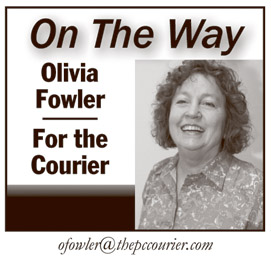Meeting ancestors, continued
When we walked through the door into our grandmother’s house on York Street, I wouldn’t have been surprised to see Grandmother and the aunts drinking coffee in the parlor. We remembered the layout of the house, as Mama had taken us to visit several times during our childhood.[cointent_lockedcontent]
 The ceilings are very high, and there’s a fireplace in almost every room. The front parlor, living room and dining room are on the right, and there are wide double wooden doors that slide back into the wall between each room. They’d slide all the doors open, creating one long open room, for parties. At Christmas, they’d have more than 100 people to dinner. Grandmama and the aunts would have a huge roast, as well as a ham and the largest turkey in existence. Everyone else brought a covered dish, and the long extended dining room table would be loaded. We remembered sitting on the stairs in the hall to eat and being all dressed up.
The ceilings are very high, and there’s a fireplace in almost every room. The front parlor, living room and dining room are on the right, and there are wide double wooden doors that slide back into the wall between each room. They’d slide all the doors open, creating one long open room, for parties. At Christmas, they’d have more than 100 people to dinner. Grandmama and the aunts would have a huge roast, as well as a ham and the largest turkey in existence. Everyone else brought a covered dish, and the long extended dining room table would be loaded. We remembered sitting on the stairs in the hall to eat and being all dressed up.
The law firm now housed there has restored the rooms to their original beauty so the house looks almost the same as we remembered. I remembered one story our grandmother had told us about her father, Horatio Cornick Hoggard, known to all as Bunny. She had a portrait of him in his Confederate uniform hanging over the fireplace in her bedroom. We wondered what had happened to it, and the attorney told us we should check the Norfolk Library, as there were several books about the Hoggard family there. So that was our next stop.
Some very helpful ladies at the library brought out one volume of the book about the Hoggards, and there we found Bunny Hoggard in his uniform. There was also a copy of a letter he’d written his oldest son explaining what was going on at the time the picture was taken.
A few pages over in the book, we found a photograph of our grandmother as a pretty young girl with her thick, curly hair piled on top of her head and tied up with a ribbon. The best surprise of all was the picture of our granddaddy taken in 1929. We’d never seen a picture of him, and it was thrilling. He’d been a surgeon in the public health service and was in uniform. We thought him very handsome.
But there was little information about him or his family. His name was Mathew Kemp Gwynn. We’d been told he was the one who added the e to the last name because of a problem with the mail, as he had three brothers who were also Dr. Gwynns and the mail was constantly being delivered to the wrong brother.
By then, we were exhausted and decided to call it a day. Because the next morning we were going to Gwynn’s Island, where we believed the Gwynn family started out in Virginia.
Gwynn’s Island is about 80 miles from Norfolk, and we arrived there mid-morning. There’s a long bridge connecting the island to the mainland, and we saw we were in a place where everything was centered upon the water. Upon driving onto the island, population 900, we were struck by its unspoiled beauty.
We made our first stop at the Gwynn’s Island Museum. We caught them open, and when my brother introduced himself as Matt Gwynne, the curator immediately called several people knowledgeable about the family to come to the museum. We spent a wonderful morning learning about our family and met some warm and hospitable people.
Hugh Gwynn had settled the island around 1640, and according to the information in the museum’s genealogy files, our grandfather was a direct descendant. We also found a letter written by his grandmother to one of his uncles during the Civil War describing conditions at home. She had sent shirts she’d made to all her sons and wanted to know if they fit.
No matter the century or circumstances, mothers always do their best to keep their children clothed and fed, and it was moving to know she was one of those mothers.
Once again, I must continue this story next week.
[/cointent_lockedcontent]




























